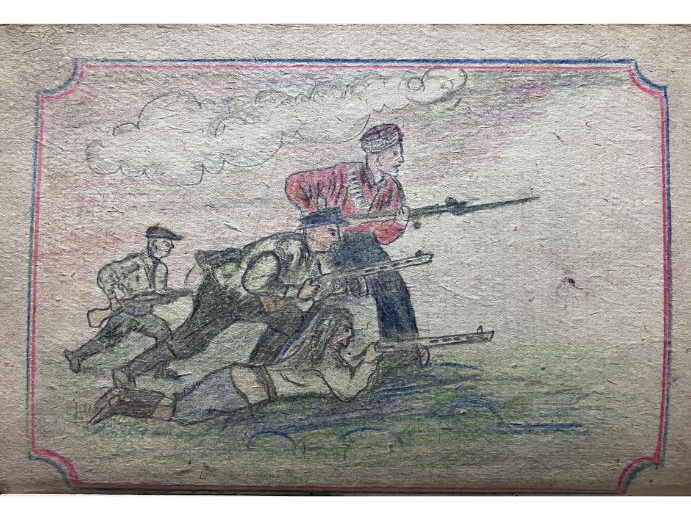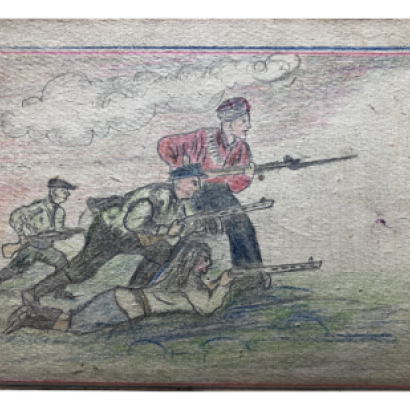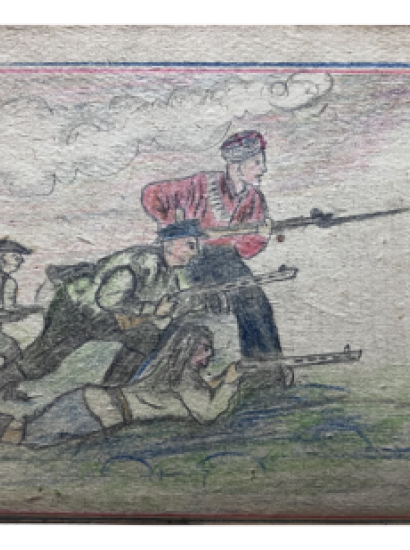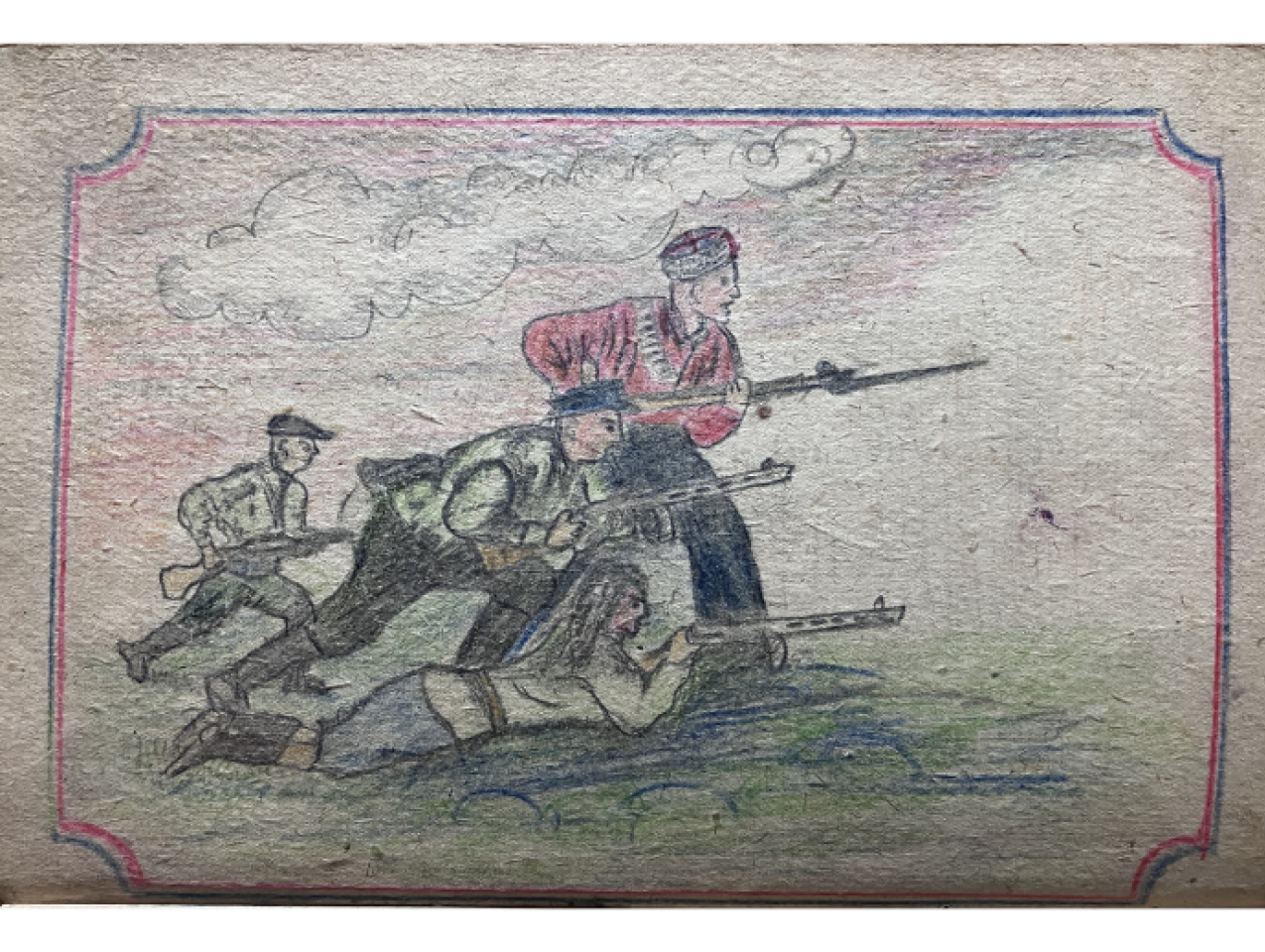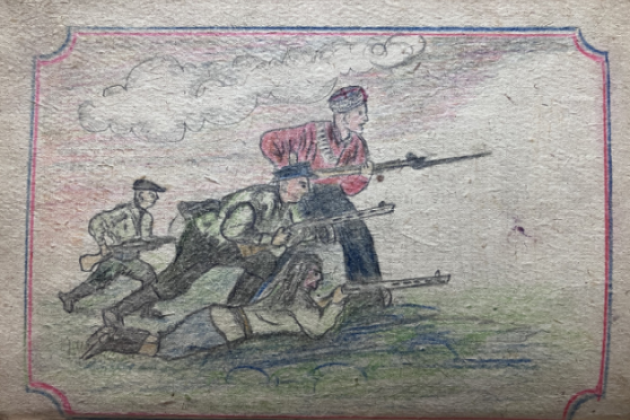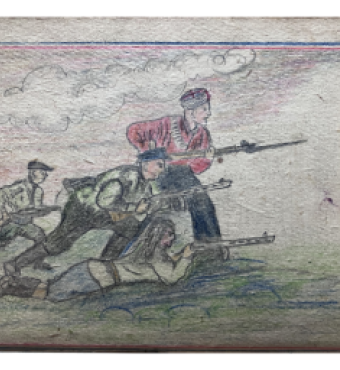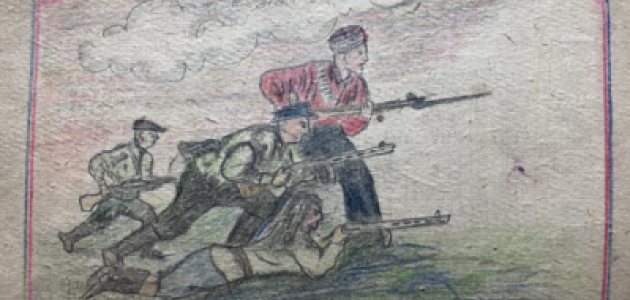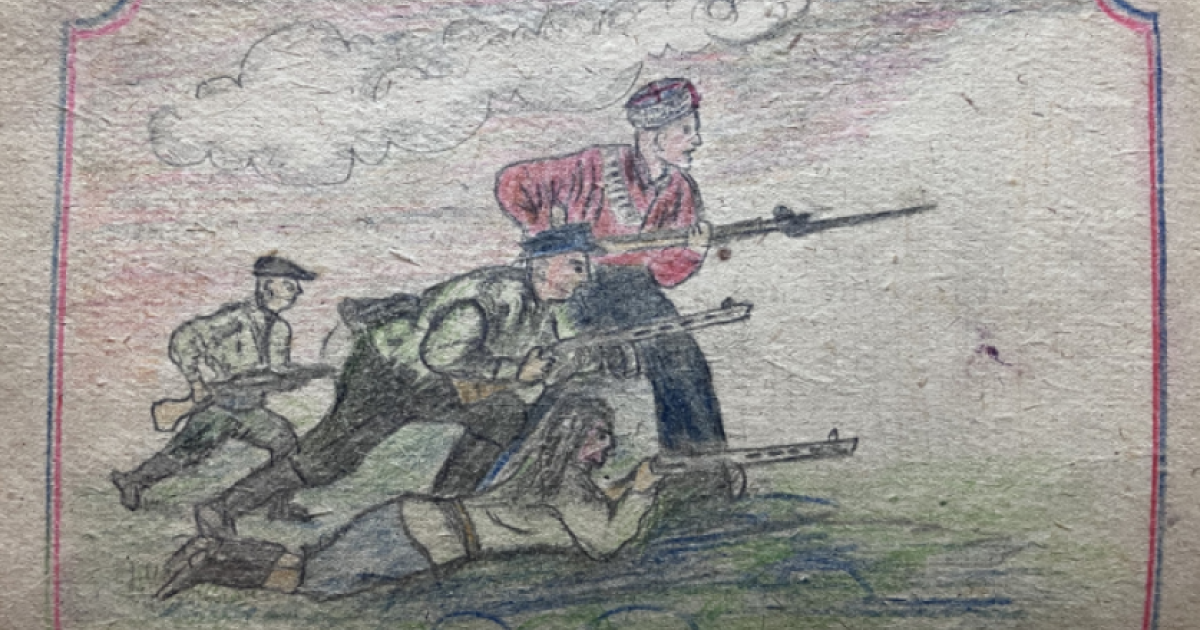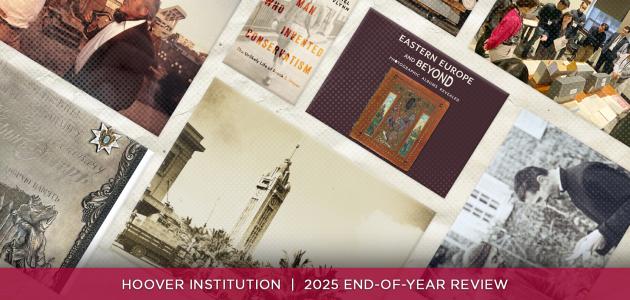![Uchisʹ u nikh bytʹ vraga. 1-i͡a chastʹ [Учись у них быть врага. 1-я часть]](/sites/default/files/2025-09/1.png)
Librarians at the Hoover Institution Library & Archives catalog hundreds of materials on a monthly basis. Here is a curated list of newly cataloged items. To view more information and to request access to these materials, follow the links to SearchWorks, the Stanford University Libraries online catalog.
![Uchisʹ u nikh bytʹ vraga. 1-i͡a chastʹ [Учись у них быть врага. 1-я часть]](/sites/default/files/2025-09/1.png)
Author: Kulikova, Vl., author: Zhuk, G., illustrator.
Title: Uchisʹ u nikh bytʹ vraga. 1-i͡a chastʹ [Учись у них быть врага. 1-я часть]
Published: [Osipovichskiĭ raĭon?], Osipovichskiĭ podpolʹnyĭ RK LKSMB, 1944.
This bound volume, issued by the Osipovichi Underground Union of Communist Youth of Belarus in February 1944, provides stories of the operations of partisan units in this region of Belarus. Entitled Uchis’ u nikh byt’ vraga (Learn From Them How to Defeat the Enemy), the volume’s 27 pages relate — in pictures and words — how the regional partisan units engaged in various operations, including sending some fifty trains hurtling off their tracks, blowing up fifteen Axis armored cars, and other successful endeavors. The “Them” in the title refers to the partisans who perished in the fight, with the unnamed authors holding them up as examples worthy of emulation. Many names are listed in the volume, and this is one of its most valuable aspects for the historian, although certainly the exploits it describes should be compared to other documents from both the Soviet and German side to see how accurate the rest of the information is. Notably, this volume is labeled as “Part 1”, but it is the only part that Hoover was able to acquire, and it is unclear if a second (or third) part was ever issued.
![Dosʹe : dokumentov o peregovorakh i podpisanii dogovora o zapreshchenii ispitaniĭ i͡adernogo oruzhii͡a v atmosfere, v kosmicheskom prostranstve i pod vodoĭ (ii͡ulʹ - avgust 1963 goda) [Досье : документов о переговорах и подписании договора о запрещении испитаний ядерного оружия в атмосфере, в космическом пространстве и под водой (июль - август 1963 года)]](/sites/default/files/2025-09/6.png)
Compiler: V.I. Ivanenko
Title: Dosʹe : dokumentov o peregovorakh i podpisanii dogovora o zapreshchenii ispitaniĭ i͡adernogo oruzhii͡a v atmosfere, v kosmicheskom prostranstve i pod vodoĭ (ii͡ulʹ - avgust 1963 goda) [Досье : документов о переговорах и подписании договора о запрещении испитаний ядерного оружия в атмосфере, в космическом пространстве и под водой (июль - август 1963 года)]
Published: [Moskva], Generalʹnyĭ Sekretariat MID SSSR, [1963]
The typescript includes texts of documents related to the negotiations and signing of the Treaty Banning Nuclear Weapon Tests in the Atmosphere, in Outer Space, and Under Water (The Test Ban Treaty of 1963), held in Moscow between July and August 1963. The publication also features telegrams sent to the Chairman of the Council of Ministers of the USSR with responses, newspaper articles about the treaty, lists of delegations, and photographs with captions. These mounted photographs serve as primary sources capturing members of the U.S., British, Soviet, Iranian, and other delegations during the treaty signing. The publication was marked for official use in the Secretariat of the Soviet Ministry of Foreign Affairs and was compiled by Vasiliĭ Ivanovich Ivanenko. Hoover acquired this monograph as part of the Oleg Alekseevich Grinevskiĭ papers.
![Miru mir [Миру мир]](/sites/default/files/2025-09/4.png)
Artists: Abramov, Mark and Bazhenov, A. ; Author of text: Mikhalkov, Sergeĭ
Title: Miru mir [Миру мир]
Published: [Moskva], Gosudarstvennoe izdatelʹstvo politicheskoĭ literatury, 1958.
This 1958 publication combines poems by Sergei Mikhalkov with color illustrations and caricatures by Mark Abramov and A. Bazhenov. The images, including the example shown here, address themes of the nuclear arms race, capitalism, racism in the United States, and Cold War tensions, presenting the struggle for peace from a Soviet perspective. The volume is supplemented with excerpts from official Soviet declarations, citations of speeches by N. S. Khrushchev, and passages from contemporary books and newspapers, interwoven to reinforce its message. Together, the poems, illustrations, and textual excerpts form a visual and literary narrative that reflects official Soviet positions during the late 1950s.
![Dumitru Nistor prizonier de război în Japonia [ドゥミトル・ニストルの画文集「捕虜として日本に生きる」]](/sites/default/files/2025-09/5.png)
Title: Dumitru Nistor prizonier de război în Japonia [ドゥミトル・ニストルの画文集「捕虜として日本に生きる」]
Published: Kasai, Kasaishi kyoiku iinkai, Kōbe daigaku daigakuin jinbungaku kenkyūka chiiki rentai sentā, 2024.
This is a Japanese-language transcription and analysis of Dumitru Nistor prizonier de război în Japonia (Dumitru Nistor prisoner of war in Japan). Nistor, a Romanian sailor serving in the Austro-Hungarian Navy, was captured by Japanese forces during World War I and kept a diary during his seven years of captivity, combining personal narrative with observations of the world around him during his imprisonment. The 2024 edition makes this diary accessible to a Japanese readership and includes vivid color facsimiles of the original manuscript.
![Gunkan Kasagi renshū kōkai kinen : Dainijūsan-ki kaigun kikan shōsa kōhosei [軍艦笠置練習航海記念 : 第二十三期海軍機関少佐候補生]](/sites/default/files/2025-09/2.png)
Title: Gunkan Kasagi renshū kōkai kinen : Dainijūsan-ki kaigun kikan shōsa kōhosei [軍艦笠置練習航海記念 : 第二十三期海軍機関少佐候補生]
Published: Tōkyō, [1915]
This commemorative volume documents a training voyage aboard the cruiser Kasagi by the 23rd class of Japanese naval engineering officer cadets. Richly illustrated with portraits and a large folded map, the work highlights naval education and warship culture in Japan on the eve of World War I. It forms part of HILA’s collection of printed materials and rare publications on Japanese Navy squadrons, assembled to support research on Japan’s naval training, warships, and maritime history in the early twentieth century.




